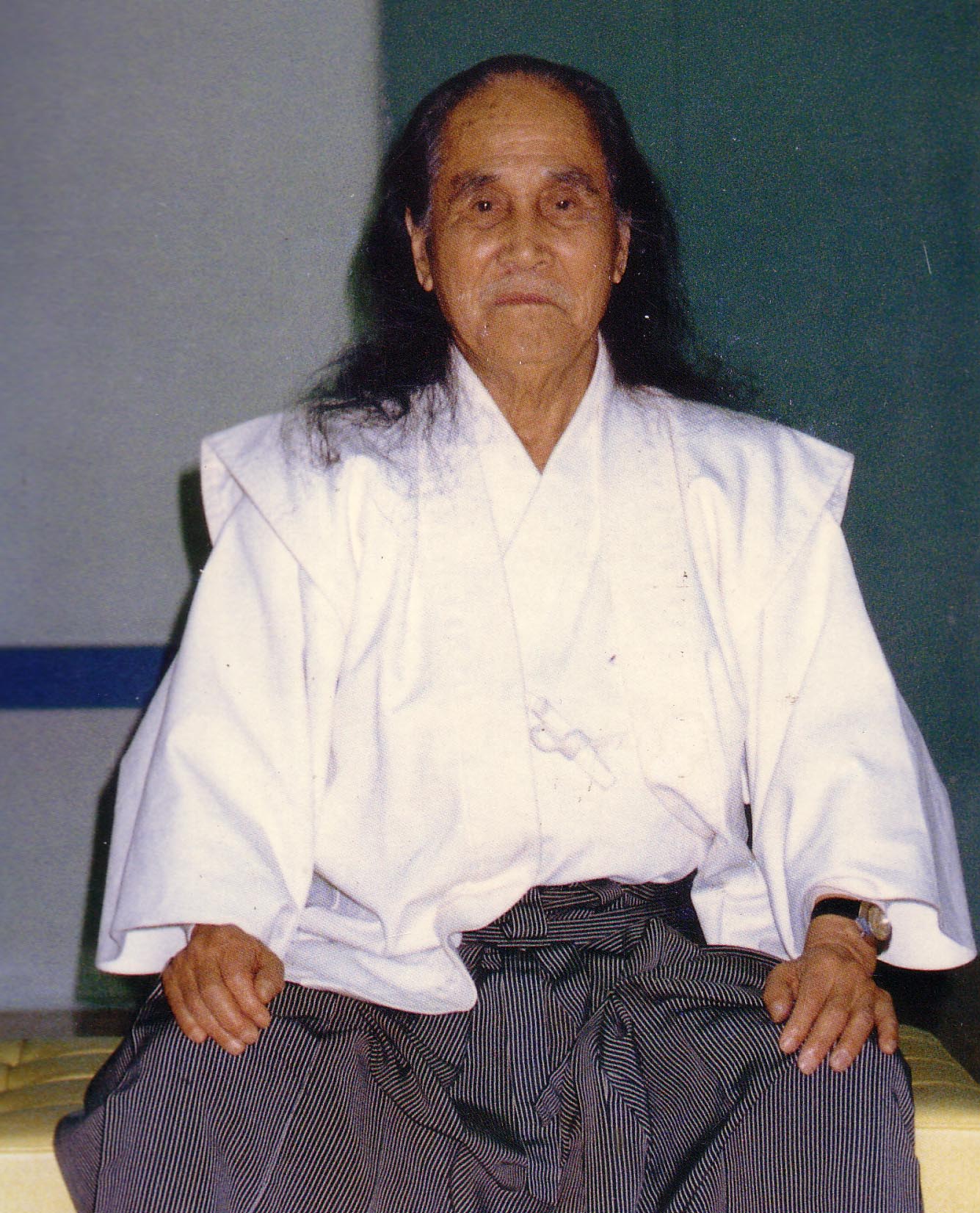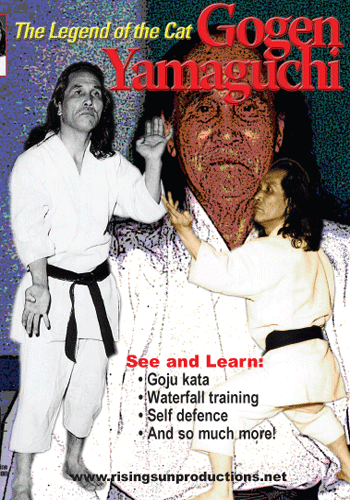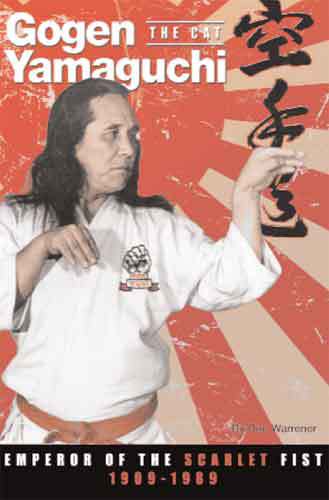Gogen "The Cat" Yamaguchi - "Emperor of the Scarlett Fist”

Gōgen Yamaguchi,
was a Japanese martial artist and student of Gōjū-ryū Karate under Chōjun Miyagi. One of the most well-known Karate-dō masters from Japan, he founded the International Karate-dōGōjū Kai Association. In  1968, he was decorated by the Emperor of Japan with
the Ranjū-Hōshō, the Blue Ribbon Medal of the fifth order of merit, for his enormous contribution to the
spread world wide of Japanese martial arts. For many years he was listed in the
Guinness Book of Records regarding his rank and achievements.
1968, he was decorated by the Emperor of Japan with
the Ranjū-Hōshō, the Blue Ribbon Medal of the fifth order of merit, for his enormous contribution to the
spread world wide of Japanese martial arts. For many years he was listed in the
Guinness Book of Records regarding his rank and achievements.
Gōgen Yamaguchi's contributions to Gōjū-ryū karate-dō and to karate-dō in general are enormous. Under his leadership and guidance the International Karate-dō Gōjū-kai Association (I.K.G.A) developed and thrived. The organization has increased in popularity both in Japan and other Asian and Western countries throughout the world. By 2008 there were approximately 60-70 countries teaching the Gōjū-kai karate-dō principles and training methods. Yamaguchi succeeded in unifying all the karate schools in Japan into a single union which resulted in the formation of The Federation of All Japan Karate-dō Organization (F.A.J.K.O.) in 1964. The Kokusai Budō Renmei - (The International Martial Arts Federation) in Japan, whose chairman was Prince Higashikuni of the Japanese Imperial Family appointed Master Yamaguchi as a Shihan - Master of that organisation's karate-dō division.
Yamaguchi began serious study of karate-dō with Sensei Takeo Maruta, student of legendary Chōjun Miyagi of Okinawa. In 1922 Yamaguchi studied Goju-Ryu Karate Kempo with Takeo Maruyama, and also trained in kendo. He studied directly with Chōjun Miyagi later in 1929, after he and his teacher and friend Jitsuei Yogi invited Miyagi to come to Japan. In 1930, Yamaguchi and Sensei Jitsuei Yogi cofounded the Ritsumei-Kan Dai-Gaku Karate Kenkyu Kai, the first Karate club at Ritsumei-Kan University. Soon the dojo became famous for its hard training. In those days only kata and yakusoku kumite (prearranged sparring) were practiced. Yamaguchi created the first stages towards jiyu kumite (free fighting) and established rules to decide the winner of a match. Yamaguchi added to the Gōjū system the Taikyoku kata forms, - training methods for beginner students to prepare for the more advanced kata. In 1932 Yamaguchi was entrusted by Master Chojun Miyagi with the task of popularizing and developing Goju-Ryu Karate-do on the Japanese mainland. He did so in partnership with Meitoku Yagi and other Miyagi students.
In pre-war Japan, Yamaguchi travelled as an intelligence officer. with the Japanese Government. Col Kanji Ishihara (1889-1949) , befriended Yamaguchi. He appointed him Commissioner in Manchuria, with combined duties as administrator, trouble-shooter, spymaster and undercover agent. Ishihara’s initial instructions were to populate the land with people from China, Russia, Japan, and Asian islands and to create a culture with equality of race and gender. This did not happen, and at the end of WW2 Yamagachi became a prisoner of war in a Russian labour camp. His captors, impressed with his knowledge of Karate, directed him to give lessons to the Russian troops.
 When he returned home to Kyoto in
1945, he was deeply upset by the state of post-war Japan. He claimed to subsequently having a mystical
experience that he carried responsibilities
to his family and Japan, with a mission to teach and spread martial arts to the
youth of Japan. He reopened his Karate
do Dojo, and to promote the art held large week long exhibitions in Tokyo. This led to a rapid expansion through a network
of independent Goju Ryu schools. With
his unmistakable flair, he built a powerful sprawling Karate empire. Returning US military personnel spread the
art of Karate into North America, spearheaded by Peter Urban, a student of
Yamaguchi who opened a New York dojo. Paul Starling, a senior pupil, spread the
art into Australia.
When he returned home to Kyoto in
1945, he was deeply upset by the state of post-war Japan. He claimed to subsequently having a mystical
experience that he carried responsibilities
to his family and Japan, with a mission to teach and spread martial arts to the
youth of Japan. He reopened his Karate
do Dojo, and to promote the art held large week long exhibitions in Tokyo. This led to a rapid expansion through a network
of independent Goju Ryu schools. With
his unmistakable flair, he built a powerful sprawling Karate empire. Returning US military personnel spread the
art of Karate into North America, spearheaded by Peter Urban, a student of
Yamaguchi who opened a New York dojo. Paul Starling, a senior pupil, spread the
art into Australia.
The Japan Karate Federation (JFK) was formed by Yamaguchi in 1950 to practice GoJuRyu Karate-do. In November 1975, the four basic kata Sanchin, Tensho, Saifa and Seiyunchin were decided, and in 1980 Gekisai Ich, Gekisai Ni, Shisochin, Sanseiru, Seisan, Seipai and Suparinpei were decided.
 Yamaguchi Sensei had five childen, recognized as exceptional martial artists and
teachers. Gosei Shihan, established himself as
president of the Gojukai USA Association. Yamaguchi Goshi Shihan, inherited the position
of president of both the IKGA and JKGA.
Son Goshi became head of the
International division.
Yamaguchi Sensei had five childen, recognized as exceptional martial artists and
teachers. Gosei Shihan, established himself as
president of the Gojukai USA Association. Yamaguchi Goshi Shihan, inherited the position
of president of both the IKGA and JKGA.
Son Goshi became head of the
International division.
Gogen Yamaguchi, a small man, projected the impression of great bulk and an aura reminiscent of the samurai era. He was dubbed “The Cat” by American GIs for his gliding walk and flowing hair. In a famous interview by French magazine Karate, he was asked whether he had the sixth sense of a cat. Yamaguichi replied:
“… today young man, if you were to face me in combat, I would be able to determine in a second the strength of your Ki, and would immediately know if you were a good opponent. It is this quality, and no other, which has given me the name of “The Cat.” Yamaguchi later introduced his famous cat-stance into his katas and kumite.
Yamaguchi Sensei established Goju-Kai Headquarters in Tokyo
Japan next to the legendary Giho-Kai Institute. Gogen Yamaguchi, 10th Dan, died on May 20, 1989. Never before has a single man had such a profound effect on the development and propagation of karate-dō. His legacy is firmly entrenched in countless hearts and minds throughout the world.
To learn more about Gogen Yamaguchi, please check out these items here!


